Drought Adaptation in the Ningxia Hui Autonomous Region, China: Actions, Planning, Pathways and Barriers
Abstract
:1. Introduction
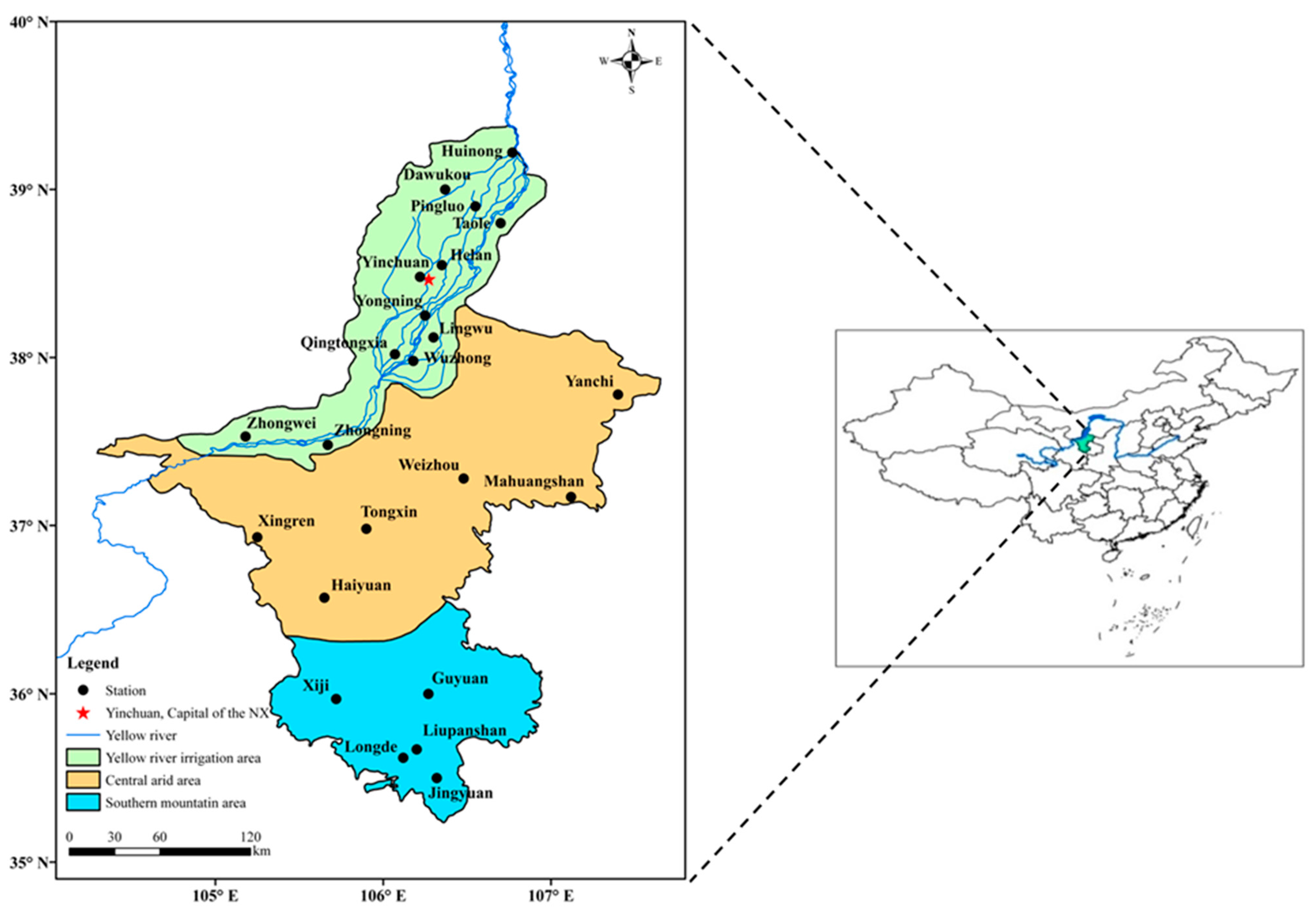
2. Study Area
| Region | Annual | Winter | Spring | Summer | Autumn | |
|---|---|---|---|---|---|---|
| Air temperature (°C) | NX | 8.2 | −5.4 | 9.6 | 20.6 | 8.1 |
| North NX | 9.5 | −5.1 | 11.2 | 22.6 | 9.3 | |
| Middle NX | 8.3 | −5.3 | 9.5 | 20.7 | 8.1 | |
| South NX | 5.2 | −6.4 | 5.9 | 15.9 | 5.3 | |
| Maximum air temperature (°C) | NX | 15.0 | 1.6 | 16.6 | 27.0 | 14.9 |
| North NX | 16.6 | 2.1 | 18.6 | 29.1 | 16.5 | |
| Middle NX | 15.2 | 2.0 | 16.5 | 27.1 | 15.0 | |
| South NX | 11.2 | 0.1 | 12.1 | 21.6 | 11.0 | |
| Minimum air temperature (°C) | NX | 2.6 | −10.8 | 3.3 | 14.8 | 3.0 |
| North NX | 3.5 | −10.6 | 4.4 | 16.5 | 3.7 | |
| Middle NX | 2.6 | −10.8 | 3.2 | 14.8 | 3.0 | |
| South NX | 0.4 | −11.3 | 0.6 | 11.0 | 1.2 | |
| Precipitation (mm) | NX | 279.4 | 7.0 | 50.1 | 159.7 | 62.6 |
| North NX | 178.2 | 3.7 | 33.1 | 103.4 | 38.0 | |
| Middle NX | 291.1 | 6.7 | 53.1 | 167.8 | 63.5 | |
| South NX | 508.5 | 15.4 | 87.4 | 285.4 | 120.3 | |
| Evaporation (mm) | NX | 1704.7 | 150.7 | 576.2 | 666.4 | 311.4 |
| North NX | 1732.6 | 141.9 | 599.1 | 675.5 | 316.1 | |
| Middle NX | 2015.0 | 178.8 | 659.4 | 807.9 | 368.9 | |
| South NX | 1265.3 | 137.9 | 421.5 | 474.8 | 231.1 |
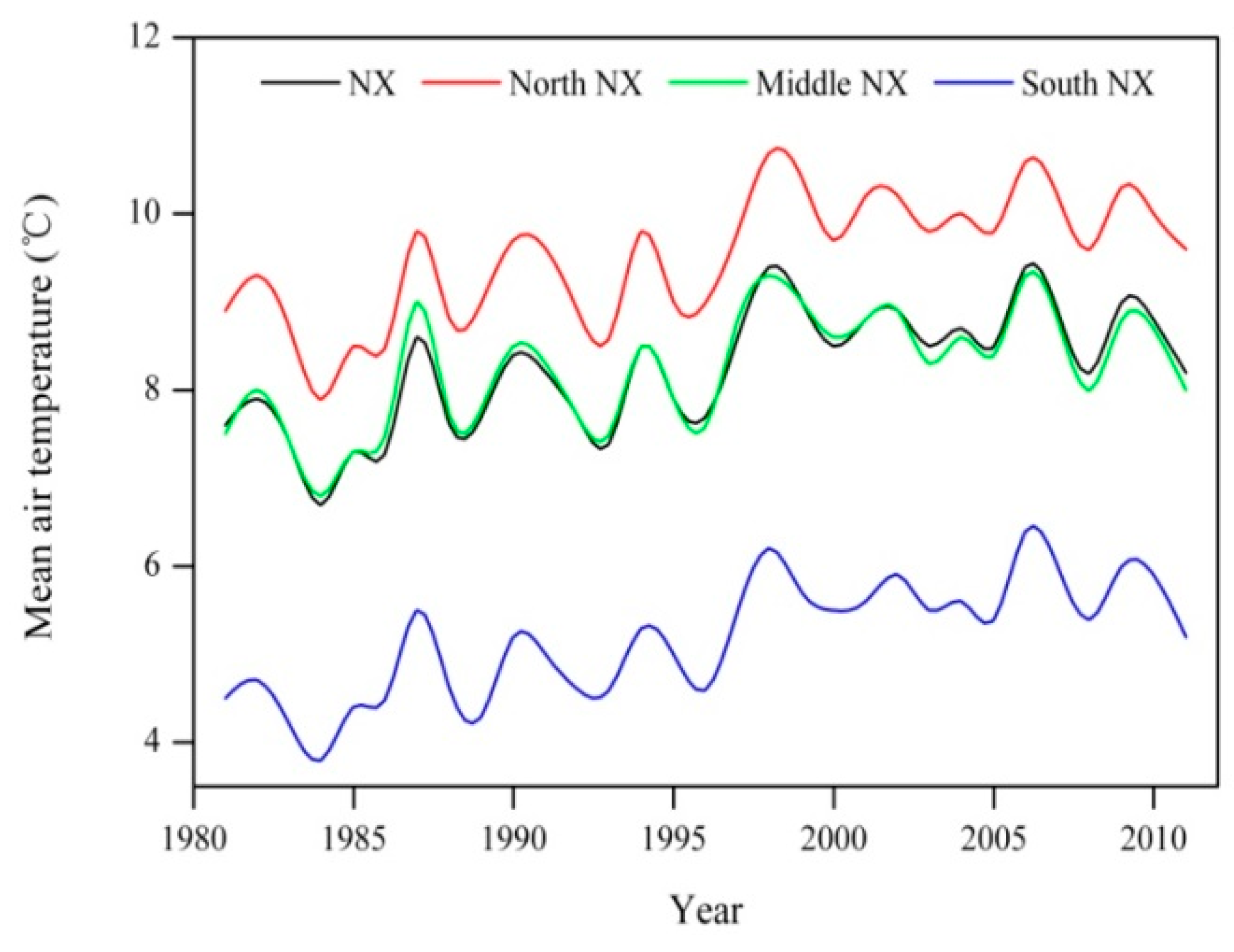
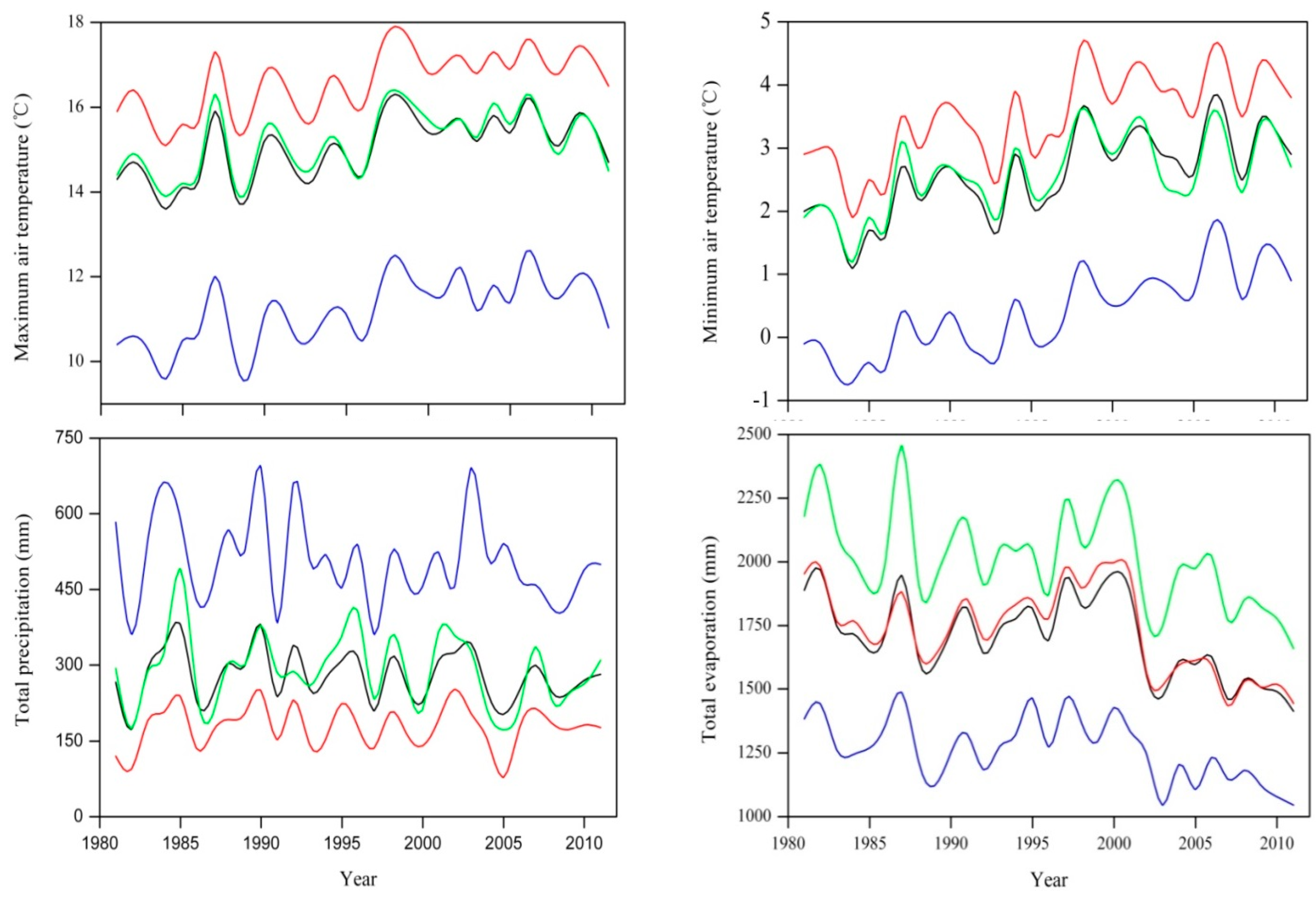
| Region | Annual | Spring | Summer | Autumn | Winter | |
|---|---|---|---|---|---|---|
| Air temperature (°C decade−1) | NX | 0.50 ** | 0.69 ** | 0.59 ** | 0.45 ** | 0.53 * |
| North NX | 0.50 ** | 0.71 ** | 0.67 ** | 0.47 ** | 0.50 * | |
| Middle NX | 0.43 ** | 0.59 ** | 0.44 ** | 0.33 * | 0.50 | |
| South NX | 0.57 ** | 0.71 ** | 0.50 ** | 0.52 ** | 0.66 * | |
| Maximum air temperature (°C decade−1) | NX | 0.53 ** | 0.70 ** | 0.58 ** | 0.43 * | 0.50 |
| North NX | 0.54 ** | 0.67 ** | 0.67 ** | 0.45 * | 0.47 | |
| Middle NX | 0.44 ** | 0.63 ** | 0.43 * | 0.31 | 0.50 * | |
| South NX | 0.57 ** | 0.80 ** | 0.50 ** | 0.44 * | 0.67 | |
| Minimum air temperature (°C decade−1) | NX | 0.50 ** | 0.65 ** | 0.63 ** | 0.53 ** | 0.55 * |
| North NX | 0.53 ** | 0.70 ** | 0.64 ** | 0.56 ** | 0.56 * | |
| Middle NX | 0.42 ** | 0.44 ** | 0.50 ** | 0.45 * | 0.50 | |
| South NX | 0.59 ** | 0.60 ** | 0.69 ** | 0.61 ** | 0.75 ** | |
| Precipitation (mm decade−1) | NX | −6.00 | −4.86 | −11.47 | 7.69 | 0.20 |
| North NX | 2.91 | −1.74 | −1.30 | 8.50 * | 0.00 | |
| Middle NX | −11.37 | −9.33 | −14.11 | 7.41 | 0.00 | |
| South NX | −25.71 | −11.89 | −24.83 | 7.36 | 1.00 | |
| Evaporation (mm decade−1) | NX | −103.42 ** | −30.11 * | −44.39 ** | −25.00 ** | 1.09 |
| North NX | −106.25 ** | −38.21 ** | −48.76 ** | −23.74 ** | 4.19 | |
| Middle NX | −104.69 ** | −30.1 | −50.67 ** | −30.33 ** | 3.71 | |
| South NX | −76.67 ** | −13.08 | −25.52 * | −19.25 ** | −7.06 * |
3. Research Design
| Questions and Options | Farmers (%) | Others (%) |
|---|---|---|
| Impacts of drought on agriculture and animal husbandry | ||
| Very great impact | 64.1 | 53.7 |
| Great impact | 23.7 | 43.1 |
| No impact | 4.0 | 0.8 |
| Small impact | 6.1 | 1.6 |
| Very small impact | 1.0 | 0.8 |
| Farmers’ adaptation practices towards drought | ||
| Saving water in daily life | 54.0 | |
| Digging the cellar to store water | 58.6 | |
| Transporting water from other sources | 50.5 | |
| Adjusting cropping structure | 39.9 | |
| Selecting drought-resistant varieties | 30.3 | |
| Reducing the number of cultivated lands | 30.3 | |
| Using micro irrigation technology | 11.1 | |
| Extracting well water | 43.3 | |
| Shifting grazing to barn feeding in captivity | 20.7 | |
| Government’s adaptation actions | ||
| Artificial precipitation | 18.2 | 63.4 |
| Development of efficient water-saving agriculture | 28.8 | 88.6 |
| Construction and renovation of reservoirs and canals | 38.4 | - |
| Water-lifting project | 25.3 | 46.3 |
| Grain for green | 69.7 | 86.2 |
| Rainwater harvesting | 40.4 | 61.8 |
| Adjusting cropping structure | - | 78.9 |
| Promotion of new drought-resistant varieties | - | 56.9 |
| Human and animal drinking water engineering | - | 65.0 |
| Establishment of early warning system | - | 47.2 |
| Establishment of prepared and rescue system | - | 59.3 |
| Reserves of emergency supplies | - | 41.5 |
| Publicity propaganda | - | 39.8 |
| Element | Option | Proportion (%) | |||||||||||
|---|---|---|---|---|---|---|---|---|---|---|---|---|---|
| North NX | Middle NX | South NX | NX | ||||||||||
| Farmer | Governmental staff | Total | Farmer | Governmental staff | Total | Farmer | Governmental staff | Total | Farmer | Governmental staff | Total | ||
| Gender | Male | 69.2 | 59.8 | 64.1 | 66.6 | 58.4 | 64.1 | 71.7 | 65.5 | 68.8 | 68 | 60.8 | 65.2 |
| Female | 30.8 | 36.1 | 33.7 | 30.7 | 40.4 | 33.6 | 26.6 | 32.1 | 29.3 | 30 | 36.9 | 32.7 | |
| Age | <18 | 0 | 0 | 0 | 0.6 | 0 | 0.4 | 0.5 | 0.6 | 0.6 | 0.5 | 0.2 | 0.4 |
| 18~44 | 41.8 | 70.4 | 57.1 | 51.2 | 76.4 | 58.7 | 52.7 | 69 | 60.5 | 50.1 | 72.7 | 58.8 | |
| 45~59 | 43.2 | 23.1 | 32.4 | 33.3 | 20.2 | 29.4 | 29.9 | 29.8 | 29.8 | 34.1 | 23.7 | 30.1 | |
| ≥60 | 14.4 | 0.6 | 7 | 13.9 | 0.4 | 9.9 | 15.2 | 0 | 8 | 14.3 | 0.3 | 8.9 | |
| Occupation | Plantation | 77.9 | 14.8 | 44.7 | 71.8 | 16.1 | 55.2 | 74 | 18.6 | 46.5 | 73.1 | 16.4 | 51.2 |
| Livestock | 5.7 | 2.2 | 3.9 | 19.4 | 5.5 | 15.3 | 21.4 | 4.7 | 13.1 | 17.6 | 4.4 | 12.5 | |
| Part-time job | 26.2 | 7.4 | 16.3 | 26.1 | 2.3 | 19 | 42 | 1.6 | 21.9 | 28.8 | 3.5 | 19.1 | |
| Self-employed | 8.2 | 1.5 | 4.7 | 4.3 | 0.9 | 3.3 | 4.6 | 0.8 | 2.7 | 5 | 1 | 3.5 | |
| Civil servant | - | 23 | 12.1 | - | 24.4 | 7.3 | - | 25.6 | 12.7 | - | 24.3 | 9.4 | |
| Enterprise and public institution | - | 40.7 | 21.4 | - | 47 | 14 | - | 46.5 | 23.1 | - | 45.1 | 17.4 | |
| Others | 1.6 | 5.9 | 3.9 | 2.7 | 2.8 | 2.8 | 1.5 | 2.3 | 1.9 | 2.4 | 3.5 | 2.8 | |
| Family annual income (RMB 10,000 yuan) | <1.0 | 8.9 | 2.4 | 5.4 | 14.1 | 4.1 | 11.1 | 13 | 1.2 | 7.4 | 13.1 | 2.8 | 9.1 |
| 1.0~5.0 | 61.6 | 49.7 | 55.2 | 64.8 | 54.7 | 61.8 | 78.8 | 53 | 66.5 | 67 | 52.8 | 61.5 | |
| 5.1~10.0 | 23.3 | 29.6 | 26.7 | 11.7 | 33.7 | 18.3 | 3.8 | 37.5 | 19.9 | 12 | 33.6 | 20.3 | |
| 10.1~20.0 | 4.1 | 4.1 | 4.1 | 3.6 | 1.1 | 2.9 | 0 | 2.4 | 1.1 | 3 | 2.3 | 2.7 | |
| >20 | 0.7 | 0 | 0.3 | 1 | 0 | 0.7 | 0 | 0.6 | 0.3 | 0.7 | 0.2 | 0.5 | |
4. Results
4.1. Drought Adaptation Actions and Planning in the NX Region
4.1.1. Macro Strategies and Planning
Eco-Environmental Construction Strategy
Strategy for Establishment of Modern Efficient Water-Saving Agriculture
Inter-Basin Water Transfer Strategy
4.1.2. Specific Coping Measures
Adjustment of Cropping Structure
Water Diversion
Dry-Farming and Water-Saving Agricultural Technologies
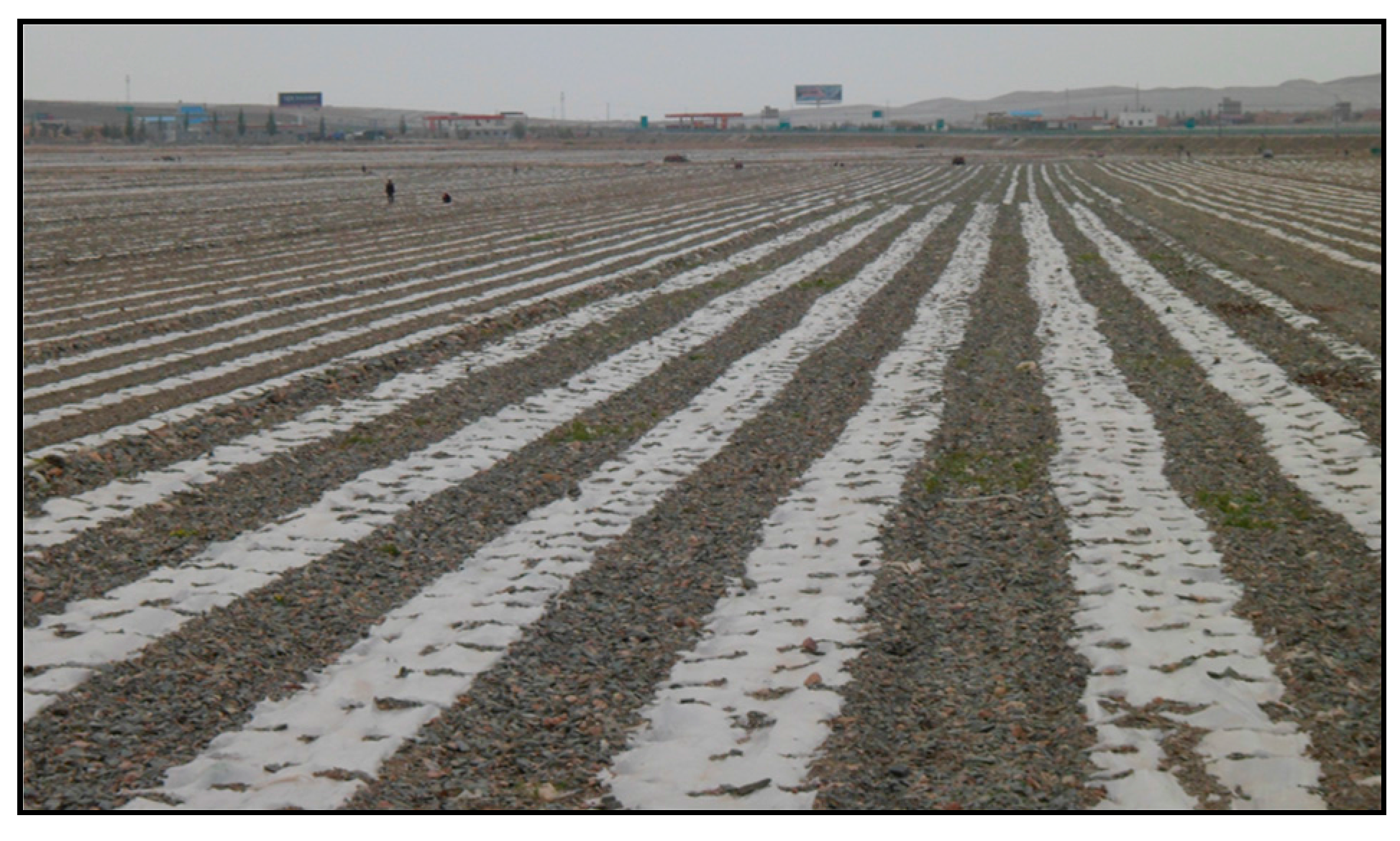
Migration Relocation
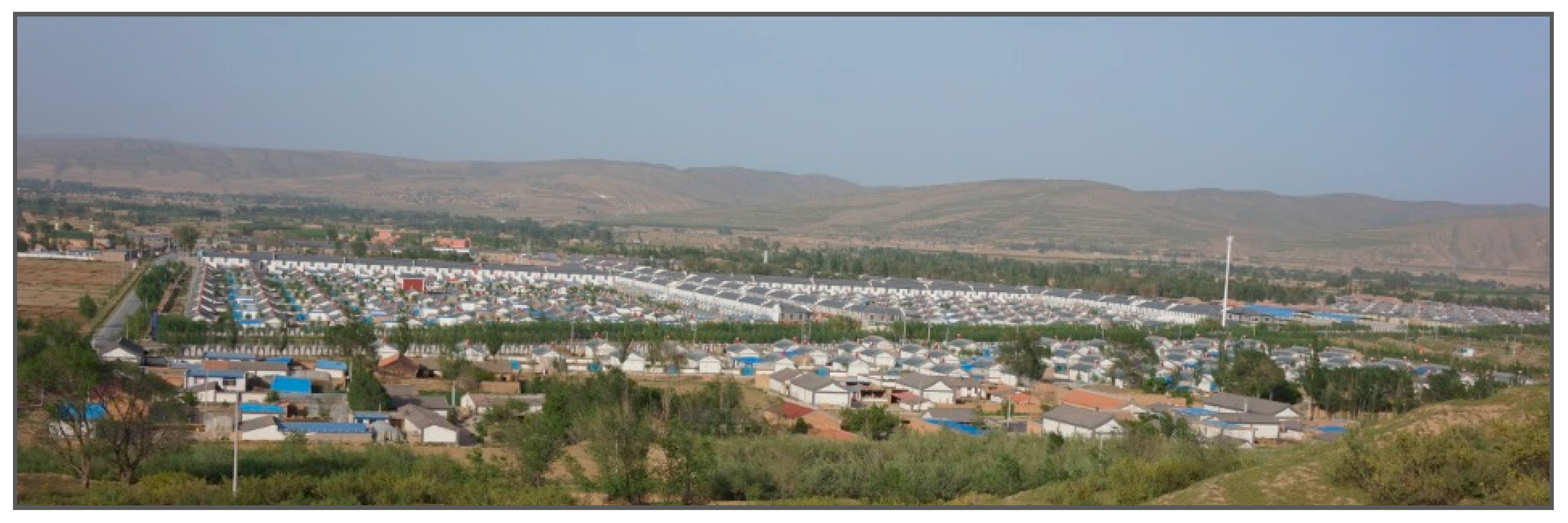
Other Measures
4.2. Adaptation Pathway and Goal
| Actions | Objective | |
|---|---|---|
| Policy and institutional | Implementation of grassland grazing prohibition in the whole NX by barn feeding in captivity and development of artificial alfalfa grassland, and grain for green | To restore degraded grassland and construct good regional eco-environment for present and future socio-economic development |
| Enacting a water-saving ordinance | According to the Ordinance, scientific utilization of water resources and water saving | |
| Setting up a water rights trading system | To use water resources efficiently | |
| Implementing the land transfer policy | To establish modern, efficient water-saving agriculture | |
| Engineering | Upgrading existing irrigation canals | To decrease water loss |
| Implementing water lifting project | To supply agricultural water and expand the area under irrigation in Middle and Southern NX regions | |
| Implementing water supply project | To supply people and livestock drinking water, ecological water, and industrial water | |
| Efficiently Operating water storage engineering such as rainwater harvesting | To make full use of limited rainfall | |
| Implementing the inter-basin water transfer project from the Yangtze River | To increase the amount of water supply and elevate largely adaptive capacity for future droughts and water shortage | |
| Technological | Implementing drought monitoring and early warning systems | To forecast drought |
| Greenhouse cropping and drip irrigation | To make full and efficient use of limited precipitation and other water resources | |
| Promoting plastic mulching | ||
| Usefulness of sand-gravel plastic mulching | ||
| Researching and promoting drought-resistant crop varieties | To heighten drought-resistant ability of crops | |
| Structural | Adjustment of cropping structure | To reduce agricultural water use |
| Social | Developing contingency and rescue plans | To strengthen prevention capacity |
| Advocating publicity | To enhance water-saving awareness | |
| Implementing migration relocation | To cope with droughts and improve survival and living environments | |
| Other | Promoting agricultural insurance | To reduce the effects of drought disasters |
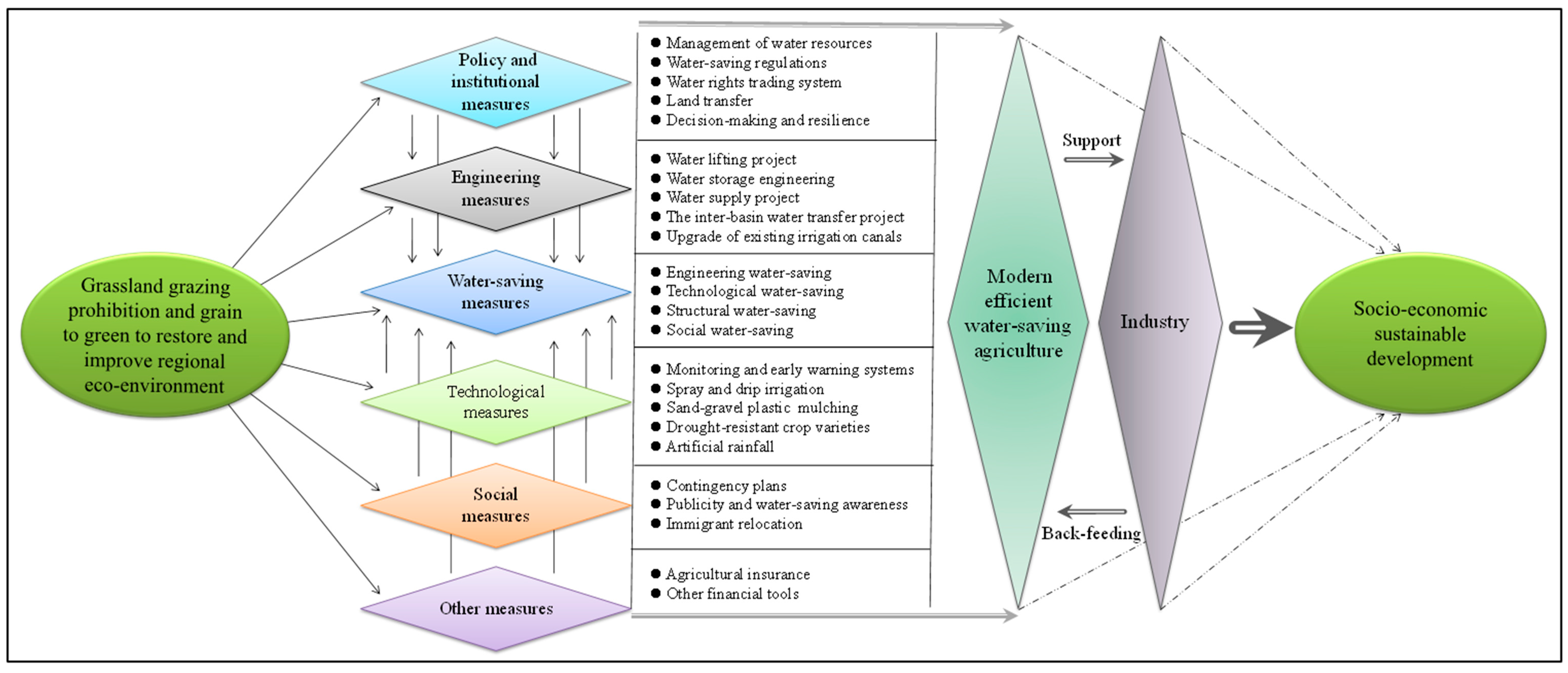
5. Discussion
5.1. Policy Barriers
5.2. Funding Barriers
5.3. Behavioral Habit Barriers
5.4. Education and Literacy Level Barriers
6. Conclusions
Supplementary Files
Supplementary File 1Acknowledgments
Author Contributions
Conflicts of Interest
References
- Intergovernmental Panel on Climate Change (IPCC). Managing the Risks of Extreme Events and Disasters to Advance Climate Change Adaptation: A Special Report of Working Groups I and II of the Intergovernmental Panel on Climate Change; Cambridge University Press: Cambridge, UK; New York, NY, USA, 2012. [Google Scholar]
- Wang, L.; Chen, W. A CMIP5 multimodel projection of future temperature, precipitation, and climatological drought in china. Int. J. Climatol. 2014, 34, 2059–2078. [Google Scholar] [CrossRef]
- United Nations International Strategy for Disaster Reduction (UNISDR). Global Assessment Report on Disaster Risk Reduction: Risk and Poverty in a Changing Climate—Invest Today for a Safer Tomorrow; United Nations International Strategy for Disaster Reduction: Geneva, Switzerland, 2009; p. 207. [Google Scholar]
- United Nations International Strategy for Disaster Reduction (UNISDR). Global Assessment Report on Disaster Risk Reduction. Revealing Risk, Redefining Development; United Nations International Strategy for Disaster Reduction: Geneva, Switzerland, 2011. [Google Scholar]
- Wilhite, D.A. Drought as a natural hazard: Concepts and definitions. In Drought: A Global Assessment. Hazards and Disasters: A Series of Definitive Major Works; Wilhite, D.A., Ed.; Routledge Publishers: London, UK, 2000. [Google Scholar]
- Elmahdi, A. Water banking—Landuse approach to improve river productivity and environmental performance. Nile Water Sci. Eng. J. 2008, 1, 94–105. [Google Scholar]
- Shahid, S. Spatial and temporal characteristics of droughts in the western part of bangladesh. Hydrol. Process. 2008, 22, 2235–2247. [Google Scholar] [CrossRef]
- Elmahdi, A.; Mainuddin, M.; Kirby, M. Water balance dynamic simulation model-WBDSim for water policy options analysis. Case Study: Murray Darling basin—Australia. In Proceedings of the 18th World IMACS Congress and MODSIM09 International Congress on Modelling and Simulation, Cairns, Australia, 13–17 July 2009; Modelling and Simulation Society of Australia and New Zealand: Cairns, Australia, 2009; pp. 2783–2789. [Google Scholar]
- Touchan, R.; Anchukaitis, K.J.; Meko, D.M.; Attalah, S.; Baisan, C.; Aloui, A. Long term context for recent drought in northwestern Africa. Geophys. Res. Lett. 2008, 35. [Google Scholar] [CrossRef]
- Elagib, N.A.; Elhag, M.M. Major climate indicators of ongoing drought in sudan. J. Hydrol. 2011, 409, 612–625. [Google Scholar] [CrossRef]
- Touchan, R.; Anchukaitis, K.J.; Meko, D.M.; Sabir, M.; Attalah, S.; Aloui, A. Spatiotemporal drought variability in northwestern africa over the last nine centuries. Clim. Dyn. 2011, 37, 237–252. [Google Scholar] [CrossRef]
- Shanahan, T.M.; Overpeck, J.T.; Anchukaitis, K.J.; Beck, J.W.; Cole, J.E.; Dettman, D.L.; Peck, J.A.; Scholz, C.A.; King, J.W. Atlantic forcing of persistent drought in West Africa. Science 2009, 324, 377–380. [Google Scholar] [CrossRef] [PubMed]
- Nicholls, N. The changing nature of australian droughts. Clim. Chang. 2004, 63, 323–336. [Google Scholar] [CrossRef]
- Wei, Y.P.; Langford, J.; Willett, I.R.; Barlow, S.; Lyle, C. Is irrigated agriculture in the Murray Darling Basin well prepared to deal with reductions in water availability? Glob. Environ. Chang. 2011, 21, 906–916. [Google Scholar] [CrossRef]
- Dulamsuren, C.; Hauck, M.; Leuschner, C. Recent drought stress leads to growth reductions in Larix sibirica in the western Khentey, Mongolia. Glob. Chang. Biol. 2010, 16, 3024–3035. [Google Scholar] [CrossRef]
- Pai, D.S.; Sridhar, L.; Guhathakurta, P.; Hatwar, H.R. District-wide drought climatology of the southwest monsoon season over india based on standardized precipitation index (SPI). Nat. Hazards 2011, 59, 1797–1813. [Google Scholar] [CrossRef]
- Udmale, P.D.; Ichikawa, Y.; Kiem, A.S.; Panda, S.N. Drought impacts and adaptation strategies for agriculture and rural livelihood in Maharashtra State of India. Open Agric. J. 2014, 8, 41–47. [Google Scholar] [CrossRef]
- Shahid, S. Rainfall variability and the trends of wet and dry periods in Bangladesh. Int. J. Climatol. 2010, 30, 2299–2313. [Google Scholar] [CrossRef]
- Zou, X.K.; Zhai, P.M.; Zhang, Q. Variations in droughts over China: 1951–2003. Geophys. Res. Lett. 2005. [Google Scholar] [CrossRef]
- Wang, X.J.; Zhang, J.Y.; Shamsuddin, S.; Amgad, E.; He, R.M.; Bao, Z.X.; Mahtab, A. Water resources management strategy for adaptation to droughts in China. Mitig. Adapt. Strateg. Glob. Chang. 2012, 17, 923–937. [Google Scholar] [CrossRef]
- Forster, P.; Jackson, L.; Lorenz, S.; Simelton, E.; Fraser, E.; Bahadur, K. Food Security: Near Future Projections of the Impact of Drought in Asia; Centre for Low Carbon Futures: Kingston upon Hull, UK, 2012. [Google Scholar]
- Tan, C.P.; Yang, J.P.; Qin, D.H.; Li, M. Climatic background of persistent drought in Ningxia Hui Autonomous Region, China. J. Desert Res. 2014, 34, 518–526. [Google Scholar]
- World Bank. Turn Down the Heat: Why a 4-Degree C Warmer World Must Be Avoided; The World Bank: Washington, DC, USA, 2012. [Google Scholar]
- Kiem, A.S. Drought and water policy in Australia: Challenges for the future illustrated by the issues associated with water trading and climate change adaptation in the Murray-Darling Basin. Glob. Environ. Chang. 2013, 23, 1615–1626. [Google Scholar] [CrossRef]
- Department of Sustainability and Environment (DSE). Securing Our Water Future Together—Our Water Our Future; DSE: Melbourne, Australia, 2004; p. 172. [Google Scholar]
- Connell, D.; Grafton, R.Q. Water reform in the Murray-Darling Basin. Water Resour. Res. 2011, 47. [Google Scholar] [CrossRef]
- Kiem, A.S.; Austin, E.K. Drought and the future of rural communities: Opportunities and challenges for climate change adaptation in regional Victoria, Australia. Glob. Environ. Chang. 2013, 23, 1307–1316. [Google Scholar] [CrossRef]
- Basin Plan. Available online: http://www.Mdba.Gov.Au/what-we-do/basin-plan (accessed on 6 December 2015).
- Mishra, A.K.; Singh, V.P. A review of drought concept. J. Hydrol. 2010, 391, 202–216. [Google Scholar] [CrossRef]
- Government of India. The Crisis Management Plan Drought; Government of India: New Delhi, India, 2006; Volume 26, pp. 1–41.
- Udmale, P.; Ichikawa, Y.; Manandhar, S.; Ishidaira, H.; Kiem, A.S. Farmers’ perception of drought impacts, local adaptation and administrative mitigation measures in Maharashtra State, India. Int. J. Disaster Risk Reduct. 2014, 10, 250–269. [Google Scholar] [CrossRef]
- Huang, Y.; Chen, X. Water demand management present and development trend of China. Adv. Water Sci. 2000, 11, 215–220. [Google Scholar]
- Qian, Z.; Chen, J.; Feng, J. From water supply management to demand management. China Water Resour. 2009, 60, 20–23. [Google Scholar]
- Wang, X.; Zhang, J.Y.; Liu, J.; Wang, G.; He, R.; Elmahdi, A.; Elsawah, S. Water resources planning and management based on system dynamics: A case study of Yulin city. Environ. Dev. Sustain. 2011, 13, 331–351. [Google Scholar] [CrossRef]
- Zhang, H. Strategic Study for Water Management in China; Southeast University Press: Nanjing, China, 2005. [Google Scholar]
- Wang, X.; Zhang, J.; Liu, J.; Wang, G.; He, R.; Wang, Y.; Zhang, M.; Lin, C. Water demand management instead of water supply management: A case study of Yulin City in northwestern China. In Proceedings of the JS. 3 at the Joint IAHS & IAH Convention, Hyderabad, India, 6–12 September 2009; IAHS Publisher: Rennes, France, 2009; Volume 330, pp. 340–346. [Google Scholar]
- Liu, C.L.; Golding, D.; Gong, G. Farmers’ coping response to the low-flows in the Lower Yellow River: A case study of temporal dimensions of vulnerability. Glob. Environ. Chang. 2008, 18, 543–553. [Google Scholar] [CrossRef]
- Kelkar, U.; Narula, K.K.; Sharma, V.P.; Chandna, U. Vulnerability and adaptation to climate variability and water stress in Uttarakhand State, India. Glob. Environ. Chang. 2008, 18, 564–574. [Google Scholar] [CrossRef]
- Waha, K.; Müller, C.; Bondeau, A.; Dietrich, J.P.; Kurukulasuriya, P.; Heinke, J.; Lotze-Campen, H. Adaptation to climate change through the choice of cropping system and sowing date in sub-Saharan Africa. Glob. Environ. Chang. 2013, 23, 130–143. [Google Scholar] [CrossRef]
- Saldana-Zorrilla, S.O. Stakeholders’ views in reducing rural vulnerability to natural disasters in Southern Mexico: Hazard exposure and coping and adaptive capacity. Glob. Environ. Chang. 2008, 18, 583–597. [Google Scholar] [CrossRef]
- Hinkel, J. Indicators of vulnerability and adaptive capacity: Towards a clarification of the science-policy interface. Glob. Environ. Chang. 2011, 21, 198–208. [Google Scholar] [CrossRef]
- Downing, T.E. Views of the frontiers in climate change adaptation economics. WIREs Clim. Chang. 2012, 3, 161–170. [Google Scholar] [CrossRef]
- Adger, W.N.; Dessai, S.; Goulden, M.; Hulme, M.; Lorenzoni, I.; Nelson, D.R.; Naess, L.O.; Wolf, J.; Wreford, A. Are there social limits to adaptation to climate change? Clim. Chang. 2009, 93, 335–354. [Google Scholar] [CrossRef]
- Amundsen, H.; Berglund, F.; Westskog, H. Overcoming barriers to climate change adaptation: A question of multilevel governance? Environ. Plan. C 2010, 28, 276–289. [Google Scholar] [CrossRef]
- Moser, S.C.; Ekstrom, J.A. A framework to diagnose barriers to climate change adaptation. Proc. Natl. Acad. Sci. USA 2010, 107, 22026–22031. [Google Scholar] [CrossRef] [PubMed]
- McNeeley, S. Examining barriers and opportunities for sustainable adaptation to climate change in Interior Alaska. Clim. Chang. 2012, 111, 835–857. [Google Scholar] [CrossRef]
- Bierbaum, R.; Smith, J.B.; Lee, A.; Blair, M.; Carter, L.; Chapin, F.; Fleming, P.; Ruffo, S.; Stults, M.; McNeeley, S.; et al. A comprehensive review of climate adaptation in the United States: More than before, but less than needed. Mitig. Adapt. Strateg. Glob. Chang. 2013, 18, 361–406. [Google Scholar] [CrossRef]
- Biesbroek, G.R.; Klostermann, J.E.; Termeer, C.J.; Kabat, P. On the nature of barriers to climate change adaptation. Reg. Environ. Chang. 2013, 13, 1119–1129. [Google Scholar] [CrossRef]
- Kiem, A.S.; Austin, E.K. Disconnect between science and end-users as a barrier to climate change adaptation. Clim. Res. 2013, 58, 29–41. [Google Scholar] [CrossRef]
- Koutsoyiannis, D.; Montanari, A.; Lins, H.F.; Cohn, T.A. Climate, hydrology and freshwater: Towards an interactive incorporation of hydrological experience into climate research—DISCUSSION of “The implications of projected climate change for freshwater resources and their management”. Hydrol. Sci. J. 2009, 54, 394–405. [Google Scholar] [CrossRef]
- Brown, C.; Werick, W.; Leger, W.; Fay, D. A Decision-Analytic Approach to Managing Climate Risks: Application to the Upper Great Lakes. J. Am. Water Resour. Assoc. 2011, 47, 524–534. [Google Scholar] [CrossRef]
- Kiem, A.S.; Verdon-Kidd, D.C. Steps towards ‘useful’ hydroclimatic scenarios for water resource management in the Murray-Darling Basin. Water Resour. Res. 2011. [Google Scholar] [CrossRef]
- Kiem, A.S.; Verdon-Kidd, D.C.; Austin, E.K. Bridging the gap between end user needs and science capability: Decision making under uncertainty. Clim. Res. 2014, 61, 57–74. [Google Scholar] [CrossRef]
- Mortazavi-Naeini, M.; Kuczera, G.; Kiem, A.S.; Cui, L.; Henley, B.; Berghout, B.; Turner, E. Robust optimization to secure urban bulk water supply against extreme drought and uncertain climate change. Environ. Model. Softw. 2015, 69, 437–451. [Google Scholar] [CrossRef]
- Kok, K.; Bärlund, I.; Flörke, M.; Holman, I.; Gramberger, M.; Sendzimir, J.; Stuch, B.; Zellmer, K. European participatory scenario development: Strengthening the link between stories and models. Clim. Chang. 2015, 128, 187–200. [Google Scholar] [CrossRef]
- Gramberger, M.; Zellmer, K.; Kok, K.; Metzger, M. Stakeholder integrated research (STIR): A new approach tested in climate change adaptation research. Clim. Chang. 2015, 128, 201–214. [Google Scholar] [CrossRef]
- China Cartographic Publishing House. China’s Different Province Atlas Series—The Atlas of Ningxia Hui Autonomous Region; China Cartographic Publishing House: Beijing, China, 2012. [Google Scholar]
- Zheng, G.F.; Chen, X.G.; Sun, Y.C.; Zhang, Z.; Na, L. The changes of temperature, precipitation, evaporation and their response to the climate warming. Sci. Meteorol. Sin. 2006, 26, 412–421. [Google Scholar]
- Li, X.; Wang, L.X.; Li, Q.; Li, J. NDVI change and its relationship with climate in Ningxia in the last 25 years. J. Arid Land Res. Environ. 2011, 25, 161–166. [Google Scholar]
- Du, L.T.; Song, N.P.; Wang, L.; Nan, L. Characteristics of drought variations in Ningxia from 1960 to 2012 under background of climate change. J. Nat. Disasters 2015, 24, 157–164. (In Chinese) [Google Scholar]
- Tan, C.P.; Yang, J.P.; Li, M. Temporal-Spatial Variation of Drought Indicated by SPI and SPEI in Ningxia Hui Autonomous Region, China. Atmosphere 2015, 6, 1399–1421. [Google Scholar] [CrossRef]
- Manandhar, S.; Vogt, D.S.; Perret, S.R.; Kazama, F. Adapting cropping systems to climate change in Nepal: Across-regional study of farmers’ perception and practices. Reg. Environ.Chang. 2011, 11, 335–348. [Google Scholar] [CrossRef]
- Habiba, U.; Shaw, R.; Takeuchi, Y. Farmers perception and adaptation practices to cope with drought: Perspectives from Nothwestern Bangladesh. Int. J. Disaster Risk Reduct. 2012, 1, 72–84. [Google Scholar] [CrossRef]
- Ashraf, M.; Routray, J.K. Perception and understanding of drought and coping strategies of farming households in north-west Balochistan. Int. J. Disaster Risk Reduct. 2013, 5, 49–60. [Google Scholar] [CrossRef]
- Keshavarz, M.; Karami, E.; Vanclay, F. The social experience of drought in rural Iran. Land Use Policy 2013, 30, 120–129. [Google Scholar] [CrossRef]
- Department of Economic and Social Affairs, Statistics Division. Designing Household Survey Samples: Practical Guidelines; Studies in Methods, Series F No. 98; United Nations: New York, NY, USA, 2005. [Google Scholar]
- Tan, C.P.; Yang, J.P.; Li, M.; Wang, S.J.; Han, C.T. Investigation and analysis on the changes, impacts and adaptations of drought in Ningxia Autonomous region, China. J. Catastrophol. 2014, 29, 84–89. (In Chinese) [Google Scholar]
- Yuan, H.Y.; Zhang, X.Y.; Xu, H.J.; Yang, X.G. Changes of China agricultural climate resources under the background of climate change V. Change characteristics of agricultural climate resources in Ningxia. Chin. J. Appl. Ecol. 2011, 22, 1247–1254. (In Chinese) [Google Scholar]
- Dasberg, S.; Or, D. Drip Irrigation; Springer: Berlin, Germany; Heidelberg, Germany, 1999. [Google Scholar]
- Polak, P.; Nanes, B.; Adhikari, D. Alow cost drip irrigation system for small farmers in developing countries. J. Am. Water Resour. Assoc. 1997, 33, 119–124. [Google Scholar] [CrossRef]
- Yohannes, F.; Tadesse, T. Effect of drip and furrow irrigation and plant spacing on yield of tomato at Dire Dawa, Ethiopia. Agric. Water Manag. 1998, 35, 201–207. [Google Scholar] [CrossRef]
- Bell, A.A.; Liu, L.; Reidy, B.; Davis, R.M.; Subbarao, K.V. Mechanisms of subsurface drip irrigation-mediated suppression of Lettuce drop caused by Sclerotinia minor. Phytopathology 1998, 88, 252–259. [Google Scholar] [CrossRef] [PubMed]
- Blaikie, S.J.; Chacko, E.K.; Lu, P.; Muller, W.J. Productivity and water relations of field-grown cashew: A comparison of sprinkler and drip irrigation. Aust. J. Exp. Agric. 2001, 41, 663–673. [Google Scholar] [CrossRef]
- Oktem, A.; Simsek, M.; Oktem, A.G. Deficit irrigation effects on sweet corn (Zea mays saccharata sturt) with drip irrigation system in a semi-arid region: I. Water-yield relationship. Agric. Water Manag. 2003, 61, 63–74. [Google Scholar] [CrossRef]
- Fabeiro, C.; de Santa Olalla, F.; Lopez, R.; Dominguez, A. Production and quality of the sugar beet (Beta vulgaris L.) cultivated under controlled deficit irrigation conditions in a semi-arid climate. Agric. Water Manag. 2003, 62, 215–227. [Google Scholar] [CrossRef]
- Lamm, F.R.; Trooien, T.P. Subsurface drip irrigation for corn production: A review of 10 years of research in Kansas. Irrig. Sci. 2003, 22, 195–200. [Google Scholar] [CrossRef]
- Şimşek, M.; Kaçɩra, M.; Tonkaz, T. The effects of different drip irrigation regimes on watermelon [Citrullus lanatus (Thunb.)] yield and yield components under semi-arid climatic conditions. Aust. J. Agric. Res. 2004, 55, 1149–1157. [Google Scholar] [CrossRef]
- Karlberg, L.; Rockstrom, J.; Annandale, J.G.; Steyn, J.M. Low-cost drip irrigation—Asuitable technology for southern African? An example with tomatoes using saline irrigation water. Agric. Water Manag. 2007, 89, 59–70. [Google Scholar] [CrossRef]
- Capra, A.; Scicolone, B. Recycling of poor quality urban wastewater by drip irrigation systems. J. Clean. Prod. 2007, 15, 1529–1534. [Google Scholar] [CrossRef]
- Dogan, E.; Kirnak, H.; Berekatoglu, K.; Bilgel, L.; Surucu, A. Water stress imposed on muskmelon (Cucumis Melo L.) with subsurface and surface drip irrigation systems under semi-arid climatic conditions. Irrig. Sci. 2008, 26, 131–138. [Google Scholar] [CrossRef]
- Kuper, M.; Bouarfa, S.; Errahj, M.; Faysse, N.; Hammani, A.; Hartani, T.; Marlet, S.; Zairi, A.; Bahri, A.; Debbarh, A.; et al. A crop needs more than a drop: Towards a new praxis in irrigation management in North Africa. Irrig. Drain. 2009, 58, S231–S239. [Google Scholar] [CrossRef]
- Dagdelen, N.; Basal, H.; Yilmaz, E.; Gurbuz, T.; Akcay, S. Different drip irrigation regimes affect cotton yield, water use efficiency and fiber quality in western Turkey. Agric. Water Manag. 2009, 96, 111–120. [Google Scholar] [CrossRef]
- Hassanli, A.M.; Ebrahimizadeh, M.A.; Beecham, S. The effects of irrigation methods with effluent and irrigation scheduling on water use efficiency and corn yields in an arid region. Agric. Water Manag. 2009, 96, 93–99. [Google Scholar] [CrossRef]
- Moyo, R.; Love, D.; Mul, M.; Mupangwa, W.; Twomlow, S. Impact and sustainability of low-head drip irrigation kits, in the semi-arid Gwanda and Beitbridge Districts, Mzingwane Catchment, Limpopo Basin, Zimbabwe. Phys. Chem. Earth 2006, 31, 885–892. [Google Scholar] [CrossRef]
- Liao, H.L. Israeli Water-Saving Agriculture: Drip Irrigation Technology. News Rep. 2011, 6, 80–81. [Google Scholar]
- Gohari, A.; Eslamian, S.; Mirchi, A.; Abedi-Koupaei, J.; Bavani, A.M.; Madani, K. Water transfer as a solution to water shortage: A fix that can Backfire. J. Hydrol. 2013, 491, 23–39. [Google Scholar] [CrossRef]
- Gleick, P.H. Water in crisis: Paths to sustainable water use. Ecol. Appl. 1998, 8, 571–579. [Google Scholar] [CrossRef]
- Cai, X.M.; McKinney, D.C.; Rosegrant, M.W. Sustainability analysis for irrigation water management in the Aral Sea region. Agric. Syst. 2003, 76, 1043–1066. [Google Scholar] [CrossRef]
- Yang, F.; Chen, C.F. Status problems and countermeasures of dry-farming and water saving agriculture in Ningxia. Ningxia J. Agric. For. Sci. Technol. 2012, 53, 59–60. (In Chinese) [Google Scholar]
- Klein, R.J.T.; Midgley, G.F.; Preston, B.L.; Alam, M.; Berkhout, F.G.H.; Dow, K.; Shaw, M.R. Adaptation Opportunities, Constraints, and Limits. In Climate Change 2014: Impacts, Adaptation and Vulnerability. Part A: Global and Sectoral Aspects; Field, C.B., Barros, V.R., Dokken, D.J., Mach, K.J., Mastrandrea, M.D., Bilir, T.E., Chatterjee, M., Ebi, K.L., Estrada, Y.O., Genova, R.C., et al., Eds.; Working Group II to the Fifth Assessment Report of the Intergovernmental Panel on Climate Change; Cambridge University Press: Cambridge, UK, 2014; pp. 899–943. [Google Scholar]
- Barnett, J.; Evans, L.S.; Gross, C.; Kiem, A.S.; Kingsford, R.T.; Palutikof, J.P.; Pickering, C.M.; Smithers, S.G. From barriers to limits to climate change adaptation: Path dependency and the speed of change. Ecol. Soc. 2015, 20. Article 5. [Google Scholar] [CrossRef]
© 2015 by the authors; licensee MDPI, Basel, Switzerland. This article is an open access article distributed under the terms and conditions of the Creative Commons Attribution license (http://creativecommons.org/licenses/by/4.0/).
Share and Cite
Yang, J.; Tan, C.; Wang, S.; Wang, S.; Yang, Y.; Chen, H. Drought Adaptation in the Ningxia Hui Autonomous Region, China: Actions, Planning, Pathways and Barriers. Sustainability 2015, 7, 15029-15056. https://doi.org/10.3390/su71115029
Yang J, Tan C, Wang S, Wang S, Yang Y, Chen H. Drought Adaptation in the Ningxia Hui Autonomous Region, China: Actions, Planning, Pathways and Barriers. Sustainability. 2015; 7(11):15029-15056. https://doi.org/10.3390/su71115029
Chicago/Turabian StyleYang, Jianping, Chunping Tan, Shijin Wang, Shengxia Wang, Yuan Yang, and Hongju Chen. 2015. "Drought Adaptation in the Ningxia Hui Autonomous Region, China: Actions, Planning, Pathways and Barriers" Sustainability 7, no. 11: 15029-15056. https://doi.org/10.3390/su71115029
APA StyleYang, J., Tan, C., Wang, S., Wang, S., Yang, Y., & Chen, H. (2015). Drought Adaptation in the Ningxia Hui Autonomous Region, China: Actions, Planning, Pathways and Barriers. Sustainability, 7(11), 15029-15056. https://doi.org/10.3390/su71115029





